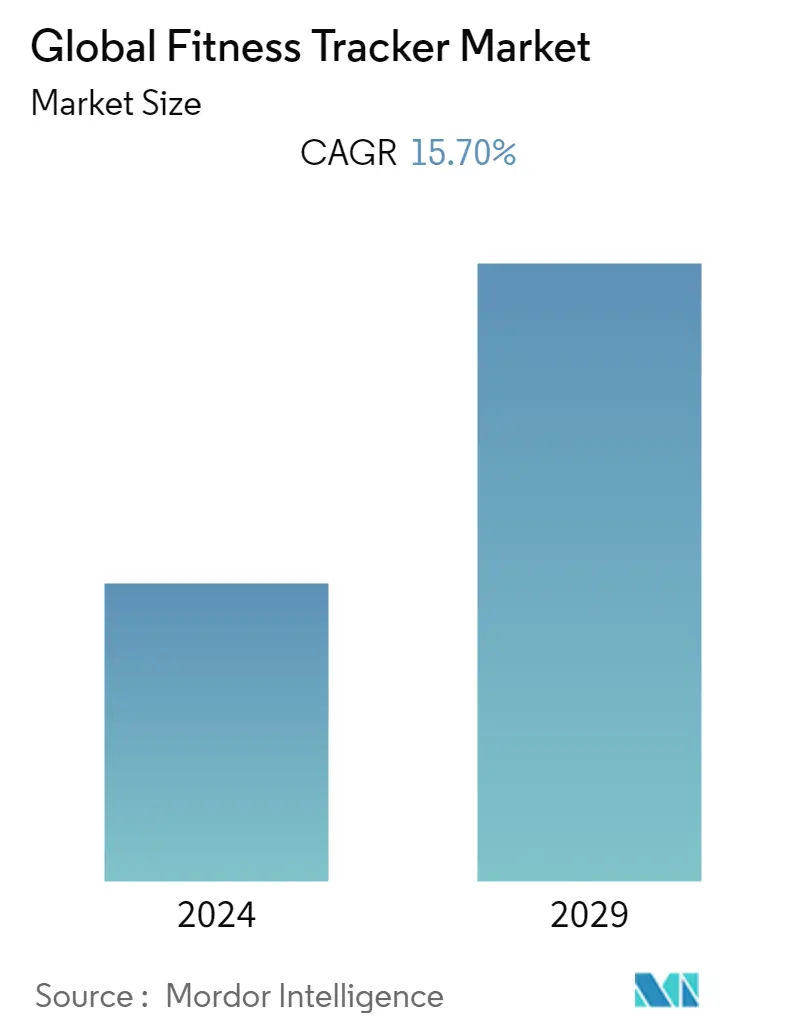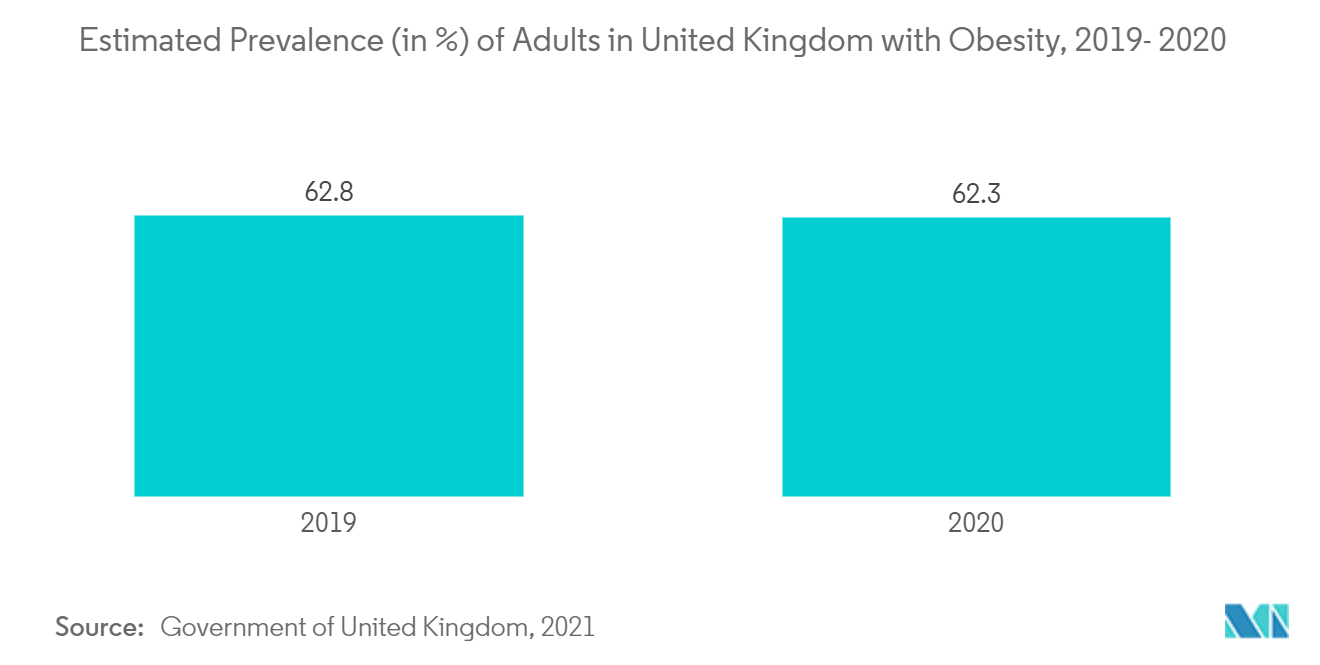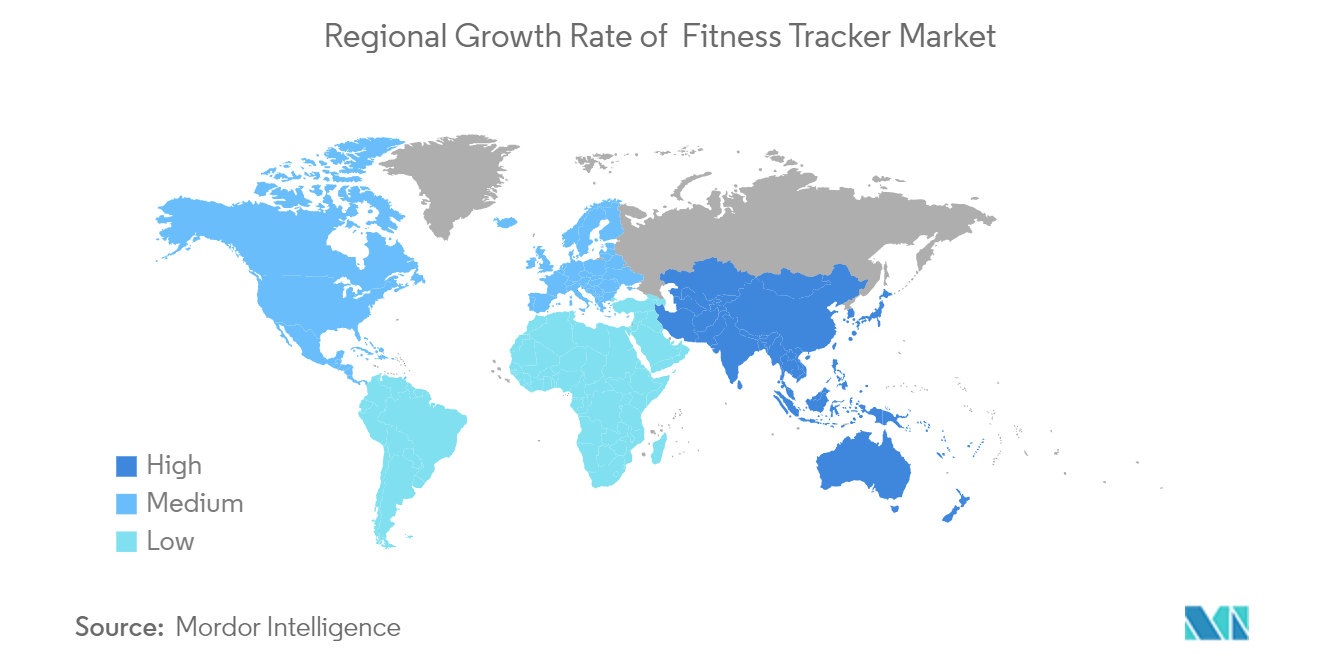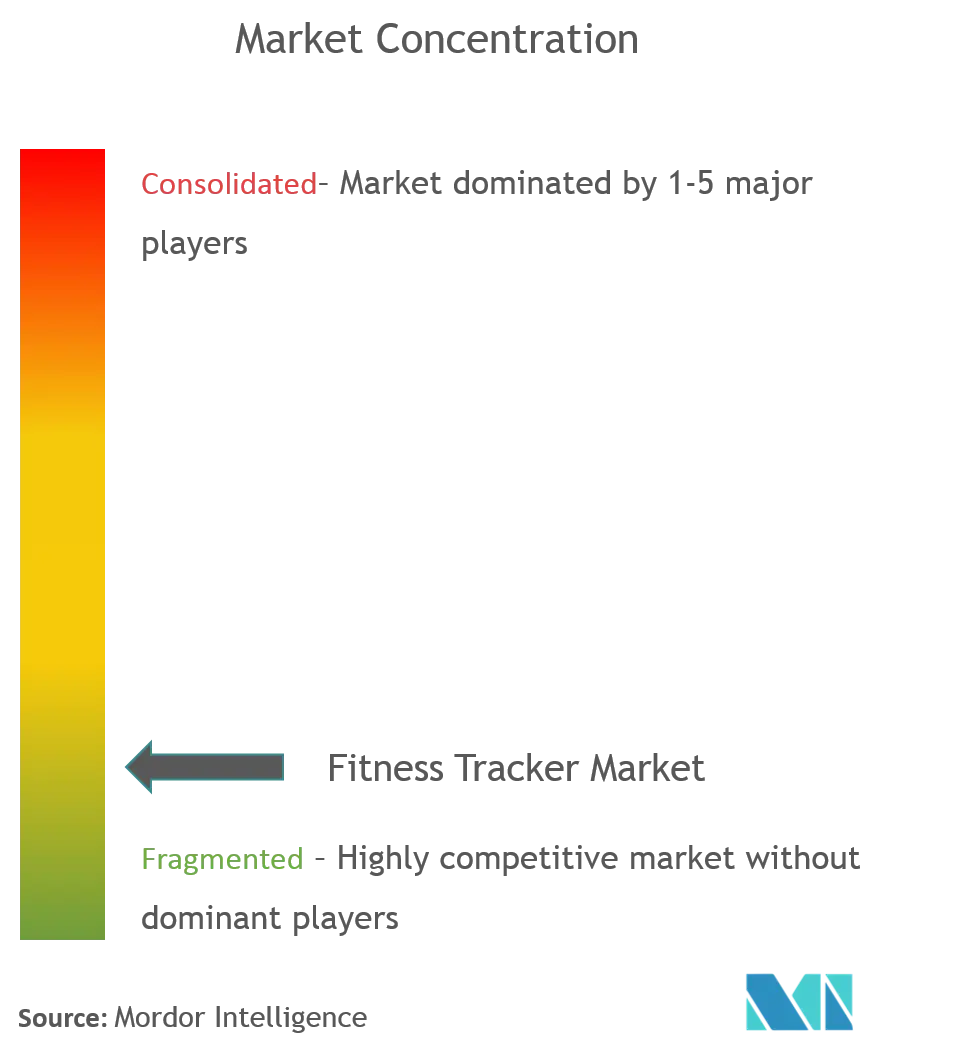Fitness Tracker Market Size

| Study Period | 2019 - 2029 |
| Base Year For Estimation | 2023 |
| Forecast Data Period | 2024 - 2029 |
| CAGR | 15.70 % |
| Fastest Growing Market | Asia-Pacific |
| Largest Market | North America |
Major Players*Disclaimer: Major Players sorted in no particular order |
Fitness Tracker Market Analysis
The fitness tracker market is projected to register a CAGR of 15.7% during the forecast period (2022-2027).
During the COVID-19 pandemic, the demand for fitness tracker products has been seen increasing due to a lot of consumption and usage of these devices to monitor heart rate and oxygen levels in the body during the pandemic. This raise in adoption has resulted in increased research and development activities in the fitness tracker segment by the key players in this market. Furthermore, the demand for these fitness trackers has increased as these gadgets are also helpful in detecting COVID-19 cases in advance. For instance, according to a study conducted by Stanford University in California in 2021, smartwatches from Apple, Gramin, and Fitbit help detect Covid-19 cases before they show signs, among asymptomatic patients. Moreover, the Covid-19 pandemic has majorly increased awareness about these devices. The increased adoption has led to the rise in device development & innovation as more market players race in to deliver the growing demand and capture a higher market share. For instance, in August 2020, Fitbit Inc. launched Sense, an advanced smartwatch that features an ECG monitor, skin temperature sensor, stress management, sleep monitor, SpO2 levels monitor, built-in GPS, period tracker, and 20+ exercise modes. Thus, COVID-19 has a significant impact on the target market.
Certain factors which have contributed to the growth of the market include rising awareness among people on health, rising prevalence of cardiovascular diseases (CVD) and obesity, and growing penetration of the internet and smartphones among others. Many people are focusing on their health and are engaged in physical activities such as walking, running, cycling, and other recreational activities. Physical activity has been shown to aid in the prevention and management of non-communicable diseases such as heart disease, stroke, diabetes, and a variety of malignancies. It also aids in the prevention of hypertension, the maintenance of healthy body weight, and the enhancement of mental health, quality of life, and overall well-being.
The growing prevalence of obesity and other risk factors are expected to have a significant impact on the growth of the fitness tracker market as the awareness among the people is increasing with the advancement and easy availability of the tracking devices. For example, obesity is a major risk factor for various cardiovascular disease and as per the June 2021 update of the World Health Organization (WHO), the obesity prevalence have tripled since 1975, with about 39 million children of age below five years were obese in 2020 which is expected to increase over the years and that is expected to increase the demand of the fitness tracking devices as self-awareness and disease prevalence increases, therefore fueling growth in the fitness tracker market over forecast period.
Several studies have shown that obesity results in cardiovascular risk factors such as dyslipidemia, type 2 diabetes, hypertension, and sleep disturbances, thereby resulting in a higher prevalence of cardiovascular diseases and deaths across the globe. For instance, in December 2021, as per the International Diabetes Federation Atlas Tenth edition of 2021 report estimated that around 537 million adults (20-79 years) are living with diabetes. The total number of people living with diabetes is projected to rise to 643 million by 2030 and 783 million by 2045. Thus, for keeping track of heart rate the demand for fitness trackers is rising continuously. Additionally, the increasing product launches by major key players are further boosting the growth of the market. For instance, in June 2020, Xiaomi launched Mi Smart Band 5. Mi Smart Band 5 offers increased fitness tracking accuracy, women's health tracking, stress evaluation, and remote shutter control, among others.
Therefore, increasing health consciousness among people and the rising prevalence of cardiovascular diseases and obesity will result in higher adoption of fitness tracking gadgets among people, thereby propelling the market growth. While the Data security risks and the high cost of the product obstruct industry growth. During the COVID-19 pandemic, the supply chain got disrupted for months, which in turn has increased the prices of the products hampering the market growth. The strong price pressure on manufacturers and the high costs associated with high-quality fitness trackers pose a major challenge to market growth. Rising privacy and security concerns and fierce competition from other counterfeit products further obstructed the market growth. This coupled with the lack of a strong distribution network in lagging areas is expected to limit the industry growth over the forecast period.
Fitness Tracker Market Trends
This section covers the major market trends shaping the Fitness Tracker Market according to our research experts:
Smart Watches Segment is Expected to Witness Growth Over the Forecast Period
Wearable fitness tracking gadgets such as smartwatches have swiftly established themselves as an important part of consumer electronics. The most advantageous component of the smartwatch has been health monitoring. It helps the fitness enthusiast by providing important health parameters and provides information related to the diseases. As people are anxious about their health, it has thereby increased the shipments of fitness trackers. Because every smartwatch has a fitness tracker, its popularity is skyrocketing.
Moreover, there is a huge adoption of smartwatches among people these days and mobile chipset companies are also investing in these devices. For instance, Qualcomm, a mobile chipset company, is heavily investing in Smartwatches and powering smartwatches for children, seniors, and adults. This data also helps doctors by rendering some sophisticated and important information related to patients. This data assists medical experts in solving challenges such as determining the influence of a new drug or continuously monitoring the recovery state of an operated patient, among other things.
Smartwatch accelerometers could be used to detect convulsions and tremors, which could be useful for those with illnesses like epilepsy. When epileptic seizures occur, prompt and effective treatment is critical to reducing the risk of long-term physical harm. Smartwatches can be used to notify friends, family, and healthcare professionals about seizures that could result in hospitalization. Due to the versatile benefits of these smartwatches, there is a huge adoption of smartwatches. For instance, In July 2021, Garmin launched two health-focused smartwatches in India. These two smartwatches are Venu 2S and Venu 2 with features such as an AMOLED touchscreen with Gorilla Glass 3 protection, a health snapshot feature, and a boast of more than twenty-five built-in sports apps. Hence, such developments are expected to further accelerate the market growth in this segment.

North America is Expected to Hold a Significant Share in the Market and Expected to do Same in the Forecast Period
Increased attention on developing new products with the latest technologies in branded companies and expanding device popularity through digital marketing is expected to be reasons for North America to hold a significant share.
The United States contributes a significant share due to increased awareness about health and higher adoption of fitness trackers in the United States. The market is also expected to be driven by rising cases of health disorders associated with sedentary lifestyles, an increase in disposable incomes, the introduction of novel products by leading industry players, and the growing prevalence of smartphones and the internet in the United States.
For instance, In January 2020, According to Pew Research Center, estimated that almost one-in-five adults (21%) in the United States utilize a smartwatch or wearable, fitness tracker on the daily basis. The same source also stated that around three-in-ten Americans (31%) have household earnings of USD 75,000 or more and they regularly use a smartwatch or fitness tracker daily, compared to only 12% of those whose yearly family income is less than USD 30,000. This indicates that an increase in disposable incomes is also contributing to the growth of the fitness trackers market in the United States.
Higher adoption of fitness trackers by the United States due to the health disorders associated with sedentary lifestyles and higher disposable incomes has contributed to a higher regional share of the fitness trackers market.

Fitness Tracker Industry Overview
The fitness tracker market is fragmented and competitive and consists of several major players. In terms of market share, a few of the major players are currently dominating the market. Some of the companies which are currently dominating the market are Apple, Inc, Fitbit, Inc., Samsung Electronics Ltd., Fossil Inc., Huawei Technologies Ltd, Lenovo Group Limited, Sony Corporation, Jawbone Xiaomi, Nike, Inc, and Google, LLC.
Fitness Tracker Market Leaders
-
Apple, Inc.
-
Fitbit, Inc.
-
Samsung Electronics Co. Ltd
-
Fossil Group Inc.
-
Huawei Technologies Co. Ltd
*Disclaimer: Major Players sorted in no particular order

Fitness Tracker Market News
- In June 2022, Xiaomi launched its Xiaomi Band 7 fitness tracking device in the global market. This tracker is water-resistant and features over 100 sports modes.
- In January 2021, OnePlus launched a fitness band in India that features a 14-day battery life, 5ATM, and IP68 water resistance, and a dual-color band design.
Fitness Tracker Market Report - Table of Contents
1. INTRODUCTION
1.1 Study Assumptions & Market Definitions
1.2 Scope of the Study
2. RESEARCH METHODOLOGY
3. EXECUTIVE SUMMARY
4. MARKET DYNAMICS
4.1 Market Overview
4.2 Market Drivers
4.2.1 Rising Awareness on Health
4.2.2 Rising Burden of Cardiovascular Diseases & Obesity
4.2.3 Growing Penetration of Internet and Smartphones
4.3 Market Restraints
4.3.1 High Cost
4.3.2 Risk of Data Theft by Tampering Connection
4.4 Porter's Five Force Analysis
4.4.1 Threat of New Entrants
4.4.2 Bargaining Power of Buyers/Consumers
4.4.3 Bargaining Power of Suppliers
4.4.4 Threat of Substitute Products
4.4.5 Intensity of Competitive Rivalry
5. MARKET SEGMENTATION (Market Size by Value - USD million)
5.1 By Product Type
5.1.1 Fitness Band
5.1.2 Smart Watches
5.1.3 Others
5.2 By Sales Channel
5.2.1 Offline
5.2.2 Online
5.3 By Wearing Type
5.3.1 Hand Wear
5.3.2 Leg Wear
5.3.3 Head wear
5.3.4 Others
5.4 By Application
5.4.1 Heart Rate Monitoring
5.4.2 Sleep Measurement
5.4.3 Glucose Measurement
5.4.4 Women's Health
5.4.5 Others
5.5 Geography
5.5.1 North America
5.5.1.1 United States
5.5.1.2 Canada
5.5.1.3 Mexico
5.5.2 Europe
5.5.2.1 Germany
5.5.2.2 United Kingdom
5.5.2.3 France
5.5.2.4 Italy
5.5.2.5 Spain
5.5.2.6 Rest of Europe
5.5.3 Asia-Pacific
5.5.3.1 China
5.5.3.2 Japan
5.5.3.3 India
5.5.3.4 Australia
5.5.3.5 South Korea
5.5.3.6 Rest of Asia-Pacific
5.5.4 Middle East and Africa
5.5.4.1 GCC
5.5.4.2 South Africa
5.5.4.3 Rest of Middle East and Africa
5.5.5 South America
5.5.5.1 Brazil
5.5.5.2 Argentina
5.5.5.3 Rest of South America
6. COMPETITIVE LANDSCAPE
6.1 Company Profiles
6.1.1 Apple, Inc.
6.1.2 Google, LLC
6.1.3 Samsung Electronics Co. Ltd
6.1.4 Fossil Group Inc.
6.1.5 Huawei Technologies Co. Ltd
6.1.6 Lenovo Group Limited
6.1.7 Sony Corporation
6.1.8 Jawbone
6.1.9 Xiaomi
6.1.10 Nike, Inc.
- *List Not Exhaustive
7. MARKET OPPORTUNITIES AND FUTURE TRENDS
Fitness Tracker Industry Segmentation
As per the scope of this report, a fitness tracker is a wearable gadget or a computer application that records a person's daily physical activity as well as other fitness or health statistics such as calories burnt, heart rate, and oxygen level among others. The fitness tracker market is segmented by Product Type (Fitness Band, Smart Watches, and Others), By Sales Channel (Offline and Online), By Wearing Type (Hand Wear, Leg Wear, Head Wear, and Others), By Application (Heart Rate Monitoring, Sleep Measurement, Glucose Measurement, and Others), and Geography (North America, Europe, Asia-Pacific, Middle East, and Africa, and South America). The market report also covers the estimated market sizes and trends for 17 different countries across major regions, globally. The report offers the value (in USD million) for the above segments.
| By Product Type | |
| Fitness Band | |
| Smart Watches | |
| Others |
| By Sales Channel | |
| Offline | |
| Online |
| By Wearing Type | |
| Hand Wear | |
| Leg Wear | |
| Head wear | |
| Others |
| By Application | |
| Heart Rate Monitoring | |
| Sleep Measurement | |
| Glucose Measurement | |
| Women's Health | |
| Others |
| Geography | ||||||||
| ||||||||
| ||||||||
| ||||||||
| ||||||||
|
Fitness Tracker Market Research FAQs
What is the current Global Fitness Tracker Market size?
The Global Fitness Tracker Market is projected to register a CAGR of 15.70% during the forecast period (2024-2029)
Who are the key players in Global Fitness Tracker Market?
Apple, Inc., Fitbit, Inc., Samsung Electronics Co. Ltd, Fossil Group Inc. and Huawei Technologies Co. Ltd are the major companies operating in the Global Fitness Tracker Market.
Which is the fastest growing region in Global Fitness Tracker Market?
Asia-Pacific is estimated to grow at the highest CAGR over the forecast period (2024-2029).
Which region has the biggest share in Global Fitness Tracker Market?
In 2024, the North America accounts for the largest market share in Global Fitness Tracker Market.
What years does this Global Fitness Tracker Market cover?
The report covers the Global Fitness Tracker Market historical market size for years: 2019, 2020, 2021, 2022 and 2023. The report also forecasts the Global Fitness Tracker Market size for years: 2024, 2025, 2026, 2027, 2028 and 2029.
How will emerging technologies like AI impact the future of fitness trackers?
The emerging technologies like AI will impact the future of fitness trackers through a) Personalized workout plans b) Advanced sleep analysis c) Real-time coaching based on AI insights
Fitness Tracker Industry Report
The global fitness tracker market is on a significant upswing, fueled by heightened health awareness and the increasing prevalence of chronic diseases. This growth is further propelled by the seamless integration of fitness trackers with smartphones and smartwatches, alongside technological advancements that make these devices more appealing to a broad spectrum of users. The market, segmented by device type, application, and distribution channel, sees smartwatches and fitness bands at the forefront, offering advanced features and affordability. With applications expanding to include comprehensive health monitoring, the online distribution channel is enhancing the market's global reach. North America leads in market share, but rapid growth is also seen in other regions, driven by a tech-savvy younger generation and rising disposable incomes. The fitness tracker market is set for substantial growth, with opportunities for both existing players and new entrants to capture a larger market share, backed by innovations and an increasing consumer focus on health. For detailed insights, Mordor Intelligence™ provides an in-depth analysis, including market share, size, and growth forecasts, available as a free report PDF download.



